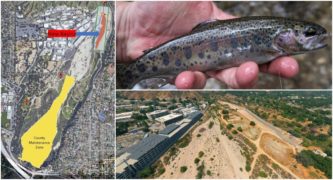 California water agencies have a tough time providing safe reliable water to their customers. I know. I served on the board of the Metropolitan Water District of Southern California for twenty-eight years and was chairman from 2006-2010.
California water agencies have a tough time providing safe reliable water to their customers. I know. I served on the board of the Metropolitan Water District of Southern California for twenty-eight years and was chairman from 2006-2010.
Many of the past engineering approaches have not produced up to expectations, and there is increasing awareness of the negative impacts of their operations and of the unprecedented challenges of climate change. So water agencies throughout California are now striving to implement Governor Newsom’s mandate to develop resilient water programs. Resilience, the governor says, is the ability “to cope with more extreme droughts and floods, rising temperatures, declining fish populations, over-reliance on groundwater and other challenges.”
But not Pasadena. Pasadena has a water crisis that it refuses to acknowledge. In the next month the City Council will consider a series of projects and programs that will have generational impacts on Pasadena and our community and test our city’s commitment to sustainability and environmental stewardship.
Next Monday, June 7th, the City Council will consider the Arroyo Seco Canyon Project (ASCP), a proposal by the Water & Power Department (PWP) to build a new dam and diversion facilities near the mouth of the Arroyo Seco and expand the spreading basins that line the east side of Hahamongna Watershed Park. The Arroyo Seco Foundation and Pasadena Audubon Society are appealing the certification of the Environmental Impact Report (EIR) for this project because we believe that ASCP will have permanent detrimental impacts on the habitat, wildlife and water resources in Hahamongna and the Arroyo Seco and on the Raymond Groundwater Basin. More than 1,000 local residents agree with us. Perhaps the best way to understand the destructive nature of this project is to read the eloquent comments of those who have signed the petition opposing it.
PWP claims that ASCP will enhance local water resources, but ultimately its purpose is to pump more water from a depleted groundwater basin without any plan to replenish the basin. The new ASCP dam and diversion facilities will drain the Arroyo stream during dry periods with no regard for impacts on fish and aquatic species.
PWP’s EIR denies there are native fish in the Arroyo. Although there have been harsh conditions in the last ten years for native fish, rainbow trout and steelhead have thrived in the Arroyo for several million years. Any doubt about their presence was destroyed last Fall when the California Department of Fish and Wildlife translocated 469 rainbow trout into the Arroyo as part of a rescue operation on the West Fork of the San Gabriel River following the Bobcat Fire. There is no longer any denying that there are actually hundreds of rainbow trout in the Arroyo Seco and that Pasadena has an obligation to be good stewards of these fish and the other natural resources of the Arroyo that it exploits. The ASCP facilities, however, were not designed to accommodate native fish.
Rainbow trout, though, are not the only important matter ASCP and its EIR ignore.
- ASCP fails to evaluate the potential impacts of climate change, relying on outdated historical patterns;
- ASCP fails to analyze the stream hydrology in the Hahamongna basin and its ability to more effectively conserve water than sterile spreading basins;
- ASCP fails to consider the negative impacts of the project on the Raymond Groundwater Basin, although it will contribute to the devastating decline of groundwater levels beneath Pasadena.
Eighty years ago Pasadena was forward-looking and worked with other local pumpers to establish a division of pumping rights to ensure a “safe” or sustainable yield from the Raymond Basin where extractions would be matched by natural replenishment. That adjudication, however, has not worked. Since it was established in 1944 the groundwater level has fallen 250 feet.
ASCP does not magically create or conserve new water. Rather it takes streamflow that would naturally percolate in the alluvial sands of Hahamongna to replenish the Raymond Basin and claims pumping rights to extract 80% of that water from that basin in the near future. PWP contends that they are helping the basin by leaving 20% of their diversions in the basin. In fact they are robbing the basin of 80% of the diverted water that would normally replenish the basin. And they don’t have a plan for replenishing the basin. That kind of arithmetic is why the groundwater level keeps falling three feet a year despite a “safe yield” adjudication. It is a cynical swindle of the groundwater basin and of future generations.
There is a better way. As the petition advocates, Pasadena should protect the natural character of our region’s greatest environmental treasures by:
- using the living Arroyo stream to capture storm flows and protect precious habitat;
- ensuring an adequate environmental flow for fish and wildlife during the dry season; and
- committing to a plan to stabilize and replenish the Raymond Groundwater Basin.
Let the River Flow, Heal the Basin
Tim Brick is the Managing Director of the Arroyo Seco Foundation














 5 comments
5 comments


